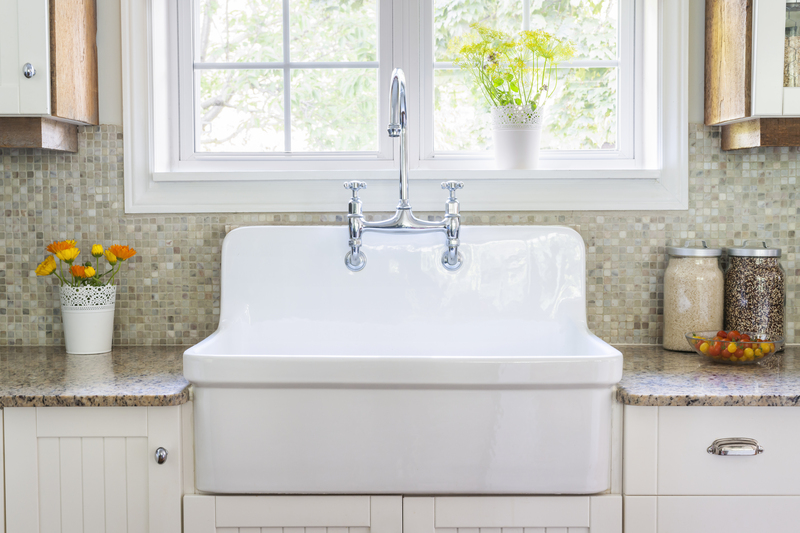Discover the Best Methods for Cleaning Burnt-On Stovetop Gunk
Posted on 21/05/2025
Discover the Best Methods for Cleaning Burnt-On Stovetop Gunk
Do you dread walking into your kitchen and seeing stubborn stains or burnt food residue sticking to your stovetop? If you've ever cooked a big meal or accidentally let a pot boil over, you know how burnt-on stovetop gunk can quickly turn into a household nightmare. This comprehensive guide explores the most effective, easy, and safe techniques for cleaning burnt stovetop grime--from time-tested home remedies to modern tools and chemical cleaners. By the end of this article, you'll have all the information you need to make your stovetop look as good as new!

Why Does Burnt-On Gunk Stick to Stovetops?
Before diving into cleaning methods for burnt-on stovetop gunk, it's helpful to understand why it's so difficult to clean. When food and liquids boil over, they often evaporate quickly, causing sugars and starches to caramelize and proteins to harden. This residue bonds to the stovetop surface, especially when subjected to repeated heat cycles. Common stovetop materials like glass, enamel, or stainless steel can all fall victim to these stubborn stains.
The Importance of Regular Stovetop Cleaning
Routine cleaning prevents gunk from accumulating and hardening into a tough layer that's harder to remove. Not only does a clean stovetop enhance the look of your kitchen, but it also reduces the risk of smoke, unpleasant odors, bacteria, and even fire hazards. Learning to clean burnt-on gunk from your stove is an essential skill for any home chef or busy parent.
Preparation: Gather Your Supplies
Whether you're tackling a small spill or a months-old crust, proper preparation will make your job easier. Here are the basic supplies for removing burnt-on gunk from your stovetop:
- Baking soda
- White vinegar
- Dish soap
- Sponge or non-abrasive scrubber
- Plastic scraper or old credit card
- Paper towels or microfiber cloth
- Gloves (optional)
- Lemon juice
- Commercial stovetop cleaner (for glass or ceramic tops)
- Razor blade (only for certain glass tops; see manufacturer's guidance)
Step-by-Step Guide: Best Methods for Cleaning Burnt-On Stovetop Gunk
1. Baking Soda and Vinegar Method
One of the most popular DIY methods for cleaning burnt-on stovetop gunk uses common kitchen ingredients--baking soda and vinegar. Their combined power is excellent at melting away stubborn residue.
Here's how to do it:
- Sprinkle baking soda generously over the affected areas.
- Pour white vinegar over the baking soda. Allow the fizzing action to break down the gunk for about 15-30 minutes.
- Gently scrub with a non-abrasive sponge in circular motions.
- Wipe the area clean with a damp microfiber cloth.
- Repeat as necessary for tough spots.
2. Hot Soapy Water and Soak Technique
For burnt-on spills that are fresh, sometimes the simplest approach works best. Soaking the area helps revive stuck-on residue.
Try this easy method:
- Mix a few drops of dish soap with hot water.
- Saturate a towel in the solution and lay it over the burnt spots for at least 20 minutes.
- Lift the towel and use a plastic scraper to gently loosen the gunk.
- Wipe down with a clean, wet cloth.
3. Commercial Glass Stovetop Cleaner
If you own a glass or ceramic stovetop, look for commercial cleaners designed for these surfaces. These products are formulated to cut through burnt-on residues without scratching.
Application is typically as follows:
- Apply a small amount of cleaner directly to the burnt area.
- Allow it to sit for the manufacturer's recommended period (usually a few minutes).
- Gently rub with a non-abrasive pad.
- Buff with a dry microfiber cloth for a streak-free shine.
4. Baking Soda Paste for Stubborn Gunk
When facing really tough stove-top stains, a thick baking soda paste adds a potent punch.
How to make and use baking soda paste:
- Mix three parts baking soda with one part water to create a paste.
- Spread the paste directly on burnt spots.
- Let it sit for 30-60 minutes.
- Scrub with a soft sponge or cloth, then rinse and dry.
5. Lemon Juice and Baking Soda
Lemon juice's natural acidity helps break down gunk and leaves your kitchen smelling fresh.
Try this effective cleaning combo:
- Sprinkle baking soda over the stains.
- Juice a lemon and pour it over the soda. Let the mixture bubble for 10-15 minutes.
- Scrub gently, then wipe clean with a damp cloth.
6. Razor Blade (For Certain Glass Tops Only!)
*Use caution: This method is only suitable for certain glass or ceramic stovetops. Always check your manufacturer's instructions first.*
For extremely hard burnt-on deposits on glass surfaces, a razor blade can help:
- Hold the blade at a shallow angle and gently scrape off burnt residue.
- Go slowly to avoid scratching the surface.
- Clean off remaining debris with a damp microfiber cloth.
7. Ammonia for Gas Burner Grates
Burner grates often collect the worst burnt-on grime.
To deep clean them:
- Remove grates from the stove.
- Seal them in a large plastic bag with a half cup of ammonia.
- Leave overnight, then rinse and scrub.
Warning: Never use ammonia on ceramic or glass stovetops!
Specialized Cleaning Methods for Different Stovetop Types
Ceramic and Glass Stovetops
- Always use non-abrasive sponges or cloths to avoid scratching the surface.
- Avoid scouring powders or steel wool.
- Clean up spills promptly before they have time to bake on.
Enamel and Porcelain Stovetops
- Most home remedies like baking soda and vinegar are safe for enamel surfaces.
- Avoid letting acidic substances (like lemon) sit too long, as they may dull the finish.
- Soft-bristled brushes are effective for stubborn areas.
Stainless Steel Stovetops
- Use a paste of baking soda and water for tough stains.
- Wipe with the grain to preserve the finish.
- Avoid harsh chemicals or steel wool, which can scratch the surface.
Natural Cleaning Solutions for Burnt-On Stovetop Gunk
For those who prefer eco-friendly methods of stovetop cleaning, these natural combinations are both effective and safe:
- Baking soda and vinegar for everyday build-up.
- Lemon juice and salt to act as a scrub, particularly on enamel finishes.
- Hydrogen peroxide and baking soda for tough, old stains (test first on a small area).
Tips and Tricks for Maintaining a Clean Stovetop
- Wipe up spills immediately after each use to prevent stains from forming.
- Deep clean your stovetop at least once per week for heavy use, or once monthly for lighter use.
- Use burner liners or drip pans (where appropriate) to catch spills before they burn on.
- Keep a spray bottle of diluted vinegar for quick daily cleaning.
- Don't forget to clean burner knobs and controls, as grease accumulates here, too!
What to Avoid When Cleaning Burnt-On Stovetop Gunk
- Never use harsh abrasives like steel wool or metal pads on glass or ceramic cooktops.
- Don't use excessive water, which can seep into electrical components in modern stoves.
- Steam cleaners are risky for some stovetops and may void warranties--check first.
- Careful with chemical cleaners: Some can cause discoloration or damage to certain finishes.
Frequently Asked Questions (FAQ)
How often should I deep clean my stovetop?
You should perform a deep clean at least once a month. However, for busy kitchens, once a week is ideal. Quick wipe-downs after every use make deep cleaning easier.
Is it safe to use a razor blade on my glass stove?
Only use a razor blade if your stove's manufacturer specifically recommends it for removing burnt-on gunk from glass. Always use a new, sharp blade held at a shallow angle and work carefully to avoid scratches.
Can I use bleach to clean burnt-on stovetop residue?
It's better to avoid bleach, as it can damage certain finishes and doesn't necessarily break down burnt food as effectively as other agents like vinegar, baking soda, or commercial stovetop cleaners.
What's the best method for cleaning gas burner grates?
For heavy build-up, soaking the grates in a sealed bag with a small amount of ammonia overnight is very effective. After soaking, scrub with a brush and rinse thoroughly.
Do commercial stovetop cleaners really work?
Yes, for glass and ceramic cooktops, specially formulated cleaners can quickly break down stuck-on gunk without damaging the surface. Always choose a product suited to your stovetop type.

Conclusion: Enjoy a Sparkling Clean Stovetop
Cleaning burnt-on stovetop gunk doesn't have to be a daunting, time-consuming task. With the right methods, supplies, and a bit of elbow grease, you can keep your stovetop looking pristine and extend its lifespan. Whether you prefer natural remedies like baking soda and vinegar or commercial cleaning solutions, consistency is key. Avoid abrasives and harsh chemicals that might scratch or dull your appliance's finish.
So, roll up your sleeves and reclaim your kitchen's shine--the satisfaction of a spotless stove is well worth the effort!




